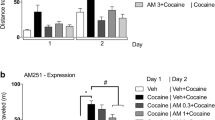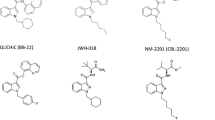Abstract
SR141716A (Sanofi Recherche), a pyrazole derivative with high affinity for rat and human CB1 cannabinoid receptors, has recently been reported to reverse biochemical, physiological and behavioral effects induced by cannabinoid agonists. The present experiments characterized the activity of SR141716A (SR) in behavioral procedures designed to assess its antagonistic and intrinsic effects on unconditioned behavior and on complex learned behaviors. Six adult male pigeons were trained to discriminate injections of 0.56 mg/kg Δ9-tetrahydrocannabinol (Δ9-THC) from vehicle under a two-key, fixed-ratio schedule of food reinforcement. SR (IM) produced a nearly complete blockade of THC-appropriate responding occasioned by the training dose without inducing significant changes in session response rates, but also produced partial substitution for Δ9-THC when administered alone. In another group of pigeons trained under a multiple schedule of signaled and unsignaled fixed consecutive number (FCN) responding, SR had little effect on accuracy, but Δ9-THC produced dose-related decreases in accuracy under both schedule components. SR was also evaluated in acoustic startle procedures in rats. SR produced little effect either on startle amplitude or prepulse inhibition of acoustic startle. In contrast, the potent cannabinomimetic CP-55, 940 produced large decreases in startle responses elicited by 120 dB [A] broad-band noise. These decreases were completely reversed by SR (10 mg/kg, IP). In concurrent measures, SR blocked the hypothermic effect CP-55,940. These results suggest that SR is an effective antagonist of the psychoactive effects of cannabinoids.
Similar content being viewed by others
References
Abood ME, Martin BR (1992) Neurobiology of marijuana abuse. Trends Pharmacol Sci 13:201–206
Campbell KA, Foster TC, Hampson RE, Deadwyler SA (1986) Δ9-Tetrahydrocannabinol differentially affects sensory-evoked potentials in the rat dentate gyrus. J Pharmacol Exp Ther 239:936–940
Compton DR, Johnson MR, Melvin LS, Martin BR (1992) Pharmacological profile of a series of bicyclic cannabinoid analogs: classification as cannabimimetic agents. J Pharmacol Exp Ther 260:201–209
Deadwyler SA, Hampson RE, Bennett BA, Edwards TA, Mu J, Pacheco MA, Ward SJ, Childers SR (1993) Cannabinoids modulate potassium current in cultured hippocampal neurons. Receptors Channels 1:121–134
Devane W, Hanus L, Breuer A, Pertwee RG, Stevenson LA, Griffin G, Gibson D, Mandelbaum A, Etinger A, Mechoulam R (1992) Isolation and structure of a brain constituent that binds to the cannabinoid receptor. Science 258:1946–1949
Doty P, Dykstra LA, Picker MJ (1992) Δ9-Tetrahydrocannabinol interactions with phencyclidine and ethanol: effects on accuracy and rate of responding. Pharmacol Biochem Behav 43:61–70
Durnett-Richardson J, Aanonsen L, Groves N, Jackson D, Hargreaves K (1995) Involvement of the spinal cannabinoid receptor in nociception. Abstracts, 1995 Symposium on Cannabis and the Cannabinoids, p 44
Geyer MA (1981) Effects of levonantradol on habituation of startle in rats. J Clin Pharmacol 2:235S-239S
Gilbert PE (1981) A comparison of THC, nantradol, nabilone, and morphine in the chronic spinal dog. J Clin Pharmacol 21:311S-319S
Herkenham M, Lynn AB, Little MD, Johnson MR, Melvin LS, De Costa BR, Rice KC (1990) Cannabinoid receptor localization in brain. Proc Natl Acad Sci USA 87:1932–1936
Heyser CJ, Hampson RE, Deadwyler SA (1993) Effects of delta-9-tetrahydrocannabinol on delayed match to sample performance in rats: alterations in short-term memory associated with changes in task specific firing of hippocampal cells. J Pharmacol Exp Ther 264:294–307
Laties VG (1972) The modification of drug effects on behavior by external discriminative stimuli. J Pharmacol Exp Ther 183:1–13
Mansbach RS (1991) Effects of NMDA receptor ligands on sensorimotor gating in the rat. Eur J Pharmacol 202:61–66
Mansbach RS, Geyer MA (1989) Effects of phencyclidine and phencyclidine biologs on sensorimotor gating in the rat. Neuropsychopharmacology 2:299–308
Mansbach RS, Nicholson KL, Martin BR, Balster RL (1994) Failure of Δ9-tetrahydrocannabinol and CP 55, 940 to maintain intravenous self-administration under a fixed-interval schedule in rhesus monkeys. Behav Pharmacol 5:219–225
Mansbach RS, Jortani SA, Balster RL (1995) Discriminative stimulus effects of esteratic local anesthetics in squirrel monkeys. Eur J Pharmacol 274:167–173
Matsuda LA, Lolait SJ, Brownstein MJ, Young AC, Bonner TI (1990) Structure of a cannabinoid receptor and functional expression of the cloned cDNA. Nature 346:561–564
Mechoulam R, Hanus L, Martin BR (1994) Search for endogenous ligands of the cannabinoid receptor. Biochem Pharmacol 48:1537–1544
Miller LL, Branconnier RJ (1983) Cannabis: effects on memory and the cholinergic limbic system. Psychol Bull 93:441–456
Razdan RK (1986) Structure-activity relationships in cannabinoids. Pharmacol Rev 38:75–149
Rinaldi-Carmona M, Barth F, Heaulme M, Shire D, Calandra B, Congy C, Martinez S, Maruani J, Neliat G, Caput D, Ferrara P, Soubrie P, Breliere JC, Le Fur G (1994) SR141716A, a potent and selective antagonist of the brain cannabinoid receptor. FEBS Lett 350:240–244
Schlinger H, Wilkenfield J, Poling A (1988) Effects of methsuximide and mephenytoin on the responding of pigeons under a fixed-consecutive-number schedule with and without an external discriminative stimulus. Psychopharmacology 95:216–221
Sipes TA, Geyer MA (1994) Multiple serotonin receptor subtypes modulate prepulse inhibition of the startle response in rats. Neuropharmacology 33:441–448
Souilhac J, Poncelet M, Rinaldi-Carmona M, Le Fur G, Soubrie P (1995) Intrastriatal injection of cannabinoid receptor agonists induced turning behavior in mice. Pharmacol Biochem Behav 51:3–7
Tsou K, Patrick SL, Walker JM (1995) Physical withdrawal in rats tolerant to Δ9-tetrahydrocannabinol precipitated by a cannabinoid receptor antagonist. Eur J Pharmacol 280:R13-R15
Wiley JL, Barrett RL, Lowe J, Balster RL, Martin BR (1995a) Discriminative stimulus effects of CP 55, 940 and structurally dissimilar cannabinoids in rats. Neuropharmacology 34:669–676
Wiley JL, Lowe JA, Balster RL, Martin BR (1995b) Antagonism of the discriminative stimulus effects of Δ9-tetrahydrocannabinol in rats and rhesus monkeys. J Pharmacol Exp Ther (in press)
Author information
Authors and Affiliations
Rights and permissions
About this article
Cite this article
Mansbach, R.S., Rovetti, C.C., Winston, E.N. et al. Effects of the cannabinoid CB1 receptor antagonist SR141716A on the behavior of pigeons and rats. Psychopharmacology 124, 315–322 (1996). https://doi.org/10.1007/BF02247436
Received:
Revised:
Issue Date:
DOI: https://doi.org/10.1007/BF02247436




